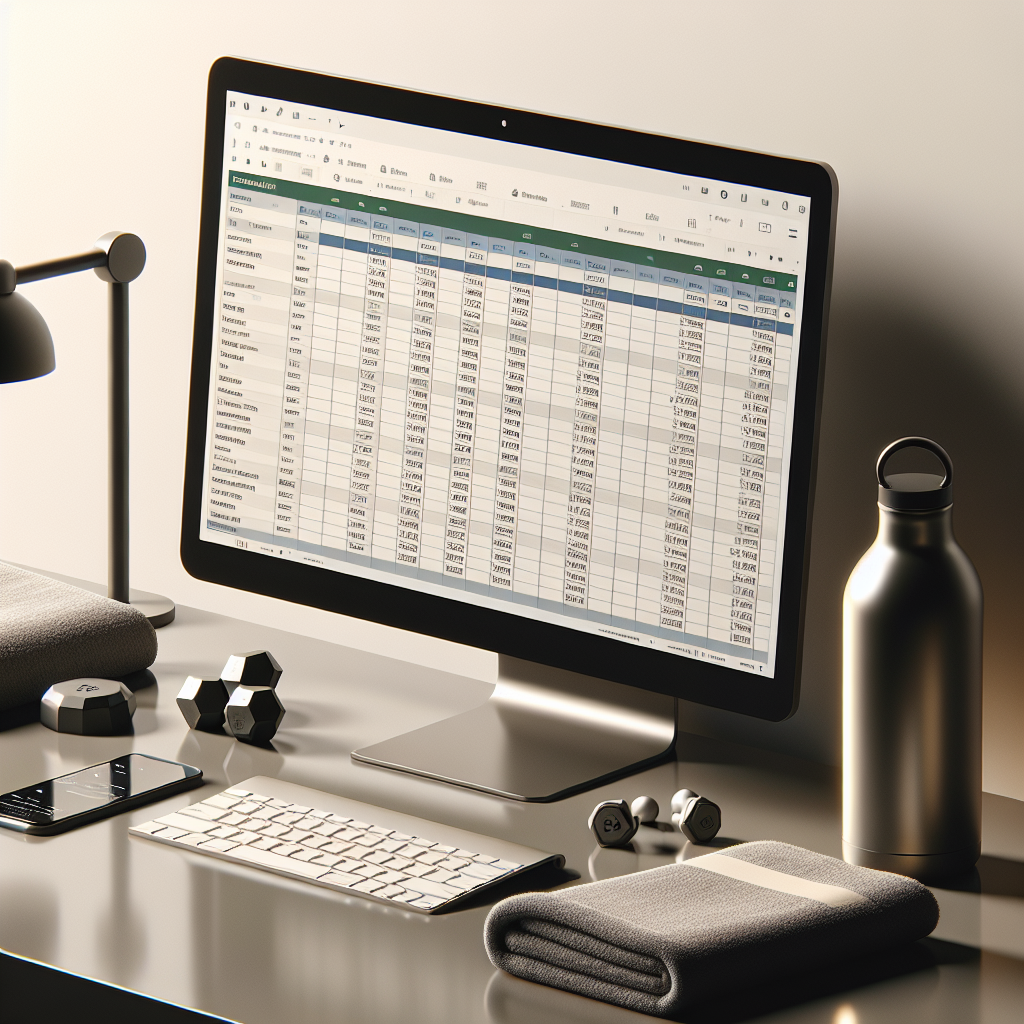Maximize Your Gains with This Workout Routine Excel Sheet!

Embarking on a fitness journey requires not just dedication but also organization. This is where a workout routine excel sheet becomes an indispensable tool. Think of it as your personal fitness planner that doesn’t just record your workouts but helps you analyze your progress over time. In an age where data is king, tracking your exercise regimen in such a detailed fashion can lead to more informed decisions about your health and fitness goals.
Whether you’re a beginner looking to get started or an experienced athlete aiming to fine-tune your training, an excel sheet provides the flexibility to customize your routines. With the ability to monitor sets, reps, weights, and rest intervals, you can create a comprehensive overview of your training program. This not only helps in ensuring variety in your workouts but also in preventing plateaus by continuously challenging your body.
Explore More at Muscle Theory to dive deeper into the world of fitness and discover how a workout routine excel sheet can transform your approach to working out. With tailored columns and formulas, you can set targets, track achievements, and visually see the progression of your strength, endurance, and overall fitness.
The Benefits of Tracking Your Fitness Progress

Keeping tabs on your fitness regime with a workout routine excel sheet brings a plethora of benefits that can significantly enhance your training outcomes. One of the primary advantages is the ability to set and monitor achievable goals. By meticulously recording each aspect of your workout, you create a roadmap that not only guides your sessions but also provides motivation as you watch your progress unfold.
Another key benefit is the increased understanding of your body’s responses to different exercises. This data-driven approach allows you to identify patterns, such as which workouts yield the best results or when you tend to hit a plateau. Consequently, you can make more informed decisions about when to intensify your workouts or when to incorporate recovery days to prevent overtraining.
Consistency is often the secret to sustained progress and with a well-organized excel sheet, it becomes easier to maintain a regular workout schedule. Moreover, it can boost your accountability. When you’re able to visualize missed workouts or inconsistencies in your training, it serves as a powerful catalyst to keep you on track.
Finally, a workout routine excel sheet can be a valuable tool for injury prevention. By tracking pain or discomfort, you can pinpoint exercises that may be causing issues and adjust your technique or routine accordingly. This proactive approach to monitoring your wellbeing is integral to enjoying a healthy and long-lasting fitness journey.
Designing Your Custom Workout Routine Excel Sheet
Designing your custom workout routine excel sheet is a strategic process that begins with outlining your fitness goals. Whether you’re aiming for strength gains, endurance enhancement, or general fitness, your excel sheet should reflect these objectives with specific columns for exercises, sets, reps, and rest periods. It’s essential to include a section for tracking the weight lifted to observe strength progress over time.
Personalization is key, so tailor your sheet to include metrics that matter to you. For some, this may involve tracking the duration of workouts or even the intensity level perceived during each session. Incorporating a column for notes can also be beneficial for jotting down how you felt during the workout or any modifications you made to the routine.
Organization is crucial for usability. Make your excel sheet user-friendly by categorizing workouts by muscle groups or by the type of training, such as cardiovascular versus resistance training. Utilize color coding for different types of activities or to highlight personal records, making the sheet visually intuitive and easy to navigate at a glance.
For those who enjoy a more data-centric approach, incorporating graphs or charts within the excel sheet can provide at-a-glance insights into your progress over weeks or months. This visual representation of data can serve as a powerful motivator and help you identify trends in your performance.
Remember, the aim is to create a functional and adaptable tool that serves your unique fitness journey. As you evolve in your training, so should your workout routine excel sheet, ensuring it remains an invaluable component of your quest for peak physical fitness.
How to Input Data and Analyze Your Progress

Once your custom workout routine excel sheet is set up, the next step is to consistently input data to track and analyze your progress. Start by entering the details of each exercise session immediately after your workout. Consistency is crucial here; the more accurate and timely the data, the better insights you will gain.
To input data effectively, first select the appropriate date and workout from your predefined categories. Then, record the specific exercises performed, the number of sets and reps, and the weights used. If your routine includes cardiovascular exercises, note down the duration and intensity of the activity. Remember to update any personal bests, as this can be a great source of motivation.
Analysis of your progress hinges on regular review of the data you’ve collected. Weekly or monthly, take time to evaluate your performance trends. Are you lifting heavier weights, performing more reps, or running longer distances? Use the built-in functions of Excel, like Conditional Formatting, to highlight improvements, or Pivot Tables to summarize your data for a high-level view.
Graphs and charts are also valuable tools within Excel for visualizing progress. For instance, a line graph plotting the increase in weights lifted over time can clearly illustrate strength gains. Similarly, a bar chart comparing your endurance metrics across different periods can help you understand your cardiovascular improvements.
Finally, don’t forget to adjust your routine based on the analysis. If you notice a plateau in certain exercises, it may be time to increase the challenge by adding weight or reps. Alternatively, if you observe consistent improvements, celebrate these achievements and use them as a foundation for setting new goals.
Tips for Optimizing Your Workout Schedule with Excel

Optimizing your workout schedule with an workout routine excel sheet can lead to better results and a more efficient fitness regime. Here are some tips to help you make the most of this powerful tool:
- Plan Macro Cycles: Think long-term by planning your training phases, such as bulking, cutting, or maintenance, in advance. Excel can help you outline these cycles and structure your workouts accordingly over several months.
- Balance Your Workouts: Use Excel to ensure you’re giving equal attention to all body parts and avoiding overtraining. You can track the frequency and intensity of workouts targeting different muscle groups to maintain a balanced schedule.
- Utilize Templates: Excel comes with a variety of templates that you can customize to fit your workout needs. Whether it’s a monthly calendar or a weekly planner, these templates can save you time setting up your routine.
- Integrate Rest Days: Schedule and track your rest days to allow for adequate recovery. Excel’s calendar view can be particularly helpful in visualizing how your rest days fit into your overall training plan.
- Set Reminders: Take advantage of Excel’s ability to set reminders for workouts, assessments, or to update your log. This can help you stay on track with your fitness goals.
- Automate Calculations: Use Excel formulas to automatically calculate totals such as weekly volume, average weights lifted, or total distance run. This can save time and provide insights into your training workload.
By employing these tips, you can create a dynamic and responsive workout schedule that adapts to your evolving fitness levels and goals. Remember, the key to an effective workout routine is not just in the planning but also in the execution and continuous refinement, all of which can be streamlined through the adept use of a workout routine excel sheet.
Common Mistakes to Avoid in Workout Tracking

While the workout routine excel sheet can be a robust tool for tracking progress, users often make certain mistakes that can hinder their fitness journey. Being aware of these pitfalls can help you maximize the efficacy of your workout tracking:
- Ignoring Consistency: Sporadic data entry leads to gaps in your tracking, which can obscure progress and trends. Make it a habit to update your workout log immediately after each session.
- Lack of Specificity: Simply noting that you ‘worked out’ is not enough. Be specific about the exercises, sets, reps, and weights used to gain meaningful insights from your data.
- Overcomplicating the Sheet: While detail is important, an overly complicated excel sheet can become daunting to maintain. Focus on what’s essential to track your progress effectively without getting lost in unnecessary data.
- Not Reviewing Past Sessions: Regularly review your previous workouts to assess progress and inform future training decisions. This retrospection can be invaluable for adjusting your routine and setting realistic goals.
- Forgetting to Backup: Always back up your data. Losing your progress due to a technical glitch can be demotivating and preventable with proper precautions.
By avoiding these common errors, you ensure that your workout routine excel sheet remains a helpful and motivating part of your fitness routine. As you continue to refine your tracking methods, remember that the goal is to support and enhance your workout experience. If you’re interested in learning more and avoiding these common pitfalls, Explore More at Muscle Theory.



